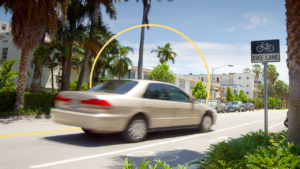How a recession could impact your car insurance

For over two years, Americans have been on an economic roller coaster — passengers on a ride we never wanted, desperately clinging to the safety bar as we twist, turn and catapult through price surges and uncertainty. However, September 2024’s inflation numbers suggest this ride may be approaching a soft landing instead of a free fall.
Cooling inflation is good news for car owners battling insurance rates, which, according to Bankrate’s analysis of Quadrant Information Services’ rate data, rose an average of 24 percent for full coverage car insurance between June 2022 and October 2024. With financial experts bouncing around terms like recession and deflation, you may wonder what to expect next for your car insurance premiums. Well, Bankrate’s team of economic and insurance experts is here to help you understand how the current economy affects your car insurance and what steps to consider when trying to cut back on insurance costs.
The current state of the economy
The term “recession” has been tossed around throughout 2023 and 2024 — but where are we headed now? Although economists waved the red flag throughout the year, the widely forecast recession never quite reared its head. In fact, Bankrate’s Q3 2024 Economic Indicator poll shows that the odds of the U.S. economy entering a recession by the end of Q3 2025 is just 33 percent.
But what is a recession? Bankrate Principal U.S. Economy and Federal Reserve Reporter Sarah Foster explains that traditionally, a recession is when the economy shrinks for six consecutive months, although the finer points are much more complex.
Data from the U.S Bureau of Labor Statistics shows that unemployment levels have remained low at 4.1 percent, and according to economists who responded to our survey, the unemployment rate is expected to hit 4.5 percent by the end of the third quarter of 2025. However, the Federal Open Market Committee (FOMC) made a bold move and cut rates by half a percentage point in September. With interest rates dropping back down to 2023 levels and inflation at its lowest since February 2021, concerns about looming inflation are easing.
“There’s only one group of economists who can make the official declaration, and that’s the National Bureau of Economic Research’s Business Cycle Dating Committee,” Foster says. “Until then, we will never truly know. But it might be the least useful question for Americans’ personal finances. ”What is useful? Understanding how sticky inflation impacts car insurance premiums.
Consumers often don’t believe economists when they celebrate just how much inflation has slowed. There’s an important caveat, though: Slowing inflation does not mean that prices are falling. It just means that they’re not increasing as fast as they once were.— Sarah Foster, Bankrate Principal U.S. Economy and Federal Reserve Reporter
Deflation vs. Disinflation
Since April and March of 2024, new and used cars and trucks have seen consistently negative inflation rates. In just September, new vehicle inflation decreased by 1.3 percent and used car and truck inflation decreased by 7.5 percent. These negative inflation rates have caused the term deflation to float to the surface of many economic debates. While this is technically true, deflation refers to when inflation rates decline into the negative; it is misleading when you consider the full economic landscape.
Despite the negative decrease in inflation, the overall rate for new vehicles is still 19.3 percent more expensive than in February 2020 and used vehicles are 23.5 percent more expensive.
Paired with the fact that almost all other items tracked by the Bureau of Labor Statistics (BLS) have either increased or decreased but remained positive, our economy is likely in a phase of disinflation. “To put that in perspective,” says Foster, “prices are up 21.4% since the pandemic, meaning consumers need an extra $214 to buy the same goods and services that once cost $1,000. And just as consumers are still catching up to inflation, so are companies.”
Both recessions and inflation “take away Americans’ ability to buy and do what they want and need,” according to Foster. Whether or not the current economic situation is ever officially dubbed a recession is just a matter of terminology. While what matters is that, due to inflation, spending power has already been reduced, it is still important to understand how a possible recession can impact your car insurance rates.
How a recession affects your car insurance
Every recession is different, which means that with each economic downturn, you may face different challenges with your car insurance. Unsurprisingly, this usually translates to higher rates and drivers needing to reassess their coverage limits.
Recessions can mean higher car insurance rates
Average auto insurance rates have been on the rise for the past several years, and 2024 is no exception. Inflation is partially to blame for the increase, according to Kenneth Chavis IV, a senior wealth advisor at Versant Capital Management: “Inflation has impacted the auto insurance industry similarly to many other industries. Over the last few years we’ve seen a sharp rise in the cost of premiums for auto insurance driven in part by inflation, specifically higher labor costs for repairs and higher replacement costs for vehicles as well as component parts when repairs are needed.”
And he is not the only one who thinks so. “We’re paying more in just about everything we consume, and [insurance] is one more additional piece,” explains Tim Grant, senior director of underwriting at LexisNexis. While the cost of car insurance will vary based on your own rating metrics, it’s likely that many consumers will continue to see increases in their premiums until more carriers reach rate stabilization.
Inflation has let up significantly over the past several months, but don’t expect car insurance rates to go down any time soon. When insurers start feeling the effects of inflation, they can’t immediately increase rates. First, they must file for approval for rate hikes with each state’s Department of Insurance, and there’s no guarantee of approval. If a rate change is approved, it generally takes effect on one date for new policies and another date for renewals. This means that it could take a full year for each company’s book of business to be affected by a rate change.
If your policy renewed for a year on Jan. 1, for example, but a rate increase for renewals went into effect on Feb. 1, you wouldn’t see your rate increase a month after your renewal. Instead, your policy would be rolled into the new rating system upon your renewal after the rate change, so Jan. 1 of the next year (if you have a 12-month policy). This means that even as inflation continues to trend downward, many drivers are likely to see higher-than-average rate increases continue into 2025.
In fact, according to S&P Global, many insurance carriers were approved for rate increases over 20 percent in Q2, some of which didn’t hit policy renewals until a few months ago. Safeco National Insurance was approved for a 21.6 percent rate increase in Maine, with a renewal effective Dec. 15, 2024. This means if your policy happens to renew on Dec. 1, you won’t see that rate change until your next renewal in 2025.
Car insurance inflation, in particular, has been one of the problem children of inflation, and it also tends to lag the rest of the U.S. economy. When the price of everything related to repairing a car — from the vehicle to the labor to the health care costs in the case of emergencies, so will the cost of insuring it.— Sarah Foster, Bankrate Principal U.S. Economy and Federal Reserve Reporter
Recessions may leave you underinsured
If you’re faced with the reduced spending power that is common in a recession, you may look at your insurance premium as a way to save money. If you’re tempted to cut your coverage back to get a lower premium, you should know that this is a risky move. Lower limits may result in a cheaper policy, but you also expose yourself to higher out-of-pocket costs if you are involved in an accident. If you trim your limits back too far and find yourself having to pay out of pocket, you could damage your finances more than if you paid for the higher limits in the first place.
Car insurance costs increased due to inflation and the rising cost of claims, but your coverage limit stays the same unless you’ve made a manual change to your policy. This means that your car insurance coverage may not go as far as it used to, considering how much more expensive the aftermath of an accident has become. Essentially, inflation may leave you underinsured.
While this mostly affects drivers who purchase state minimum coverage, it doesn’t hurt to review your car insurance limits with your agent or a representative from your company. If you feel that you may be underinsured due to inflation, you could increase your coverage to provide additional financial protection while looking for ways to offset your increases, through discounts or shopping your policy.
Recessions may prompt you to shop
Car insurance rates are rising across the industry, but that doesn’t mean that every company charges the same rates. Additionally, rates vary by state, so learning about average rates in your area could help you decide if your premium is competitive. Shopping your car insurance with multiple carriers can be an impactful way to find lower rates, and consumers seem to know this.
Data from LexisNexus suggests that, since 2021, personal auto insurance shopping leaps up in January of each year, which could be when drivers take more time to balance their budgets for the new year. Although insurance shopping was down in Q3 2023 compared to Q4 2023, with Americans’ budgets growing tighter, J.D. Power found that 49 percent of U.S. auto insurance customers were actively shopping for a new insurance policy as of May 2024.
How to save on car insurance during a recession
If you’ve seen your car insurance premium increase due to inflation, or if you simply need to find some wiggle room in your budget because of inflation’s insidious effects, you may be able to take steps to lower your premium.
Car insurance rates are at least partially within your control. Here are some steps that might help you save on your car insurance:
- Shop around: Even the best car insurance companies have different rating systems, which means the same coverage could cost more or less with different companies. For the same coverage, you could find a better deal if you shop around and compare quotes.
- Take advantage of discounts: Most insurance carriers offer car insurance discounts to help you take control of your premium. You could save by bundling your policies with one company, opting for paperless bills and statements, or paying in full.
- Use a telematics device: Telematics discounts use a plug-in device or mobile app to track your driving patterns. If the data reveals that you’re a generally safe driver, you could earn a discount.
- Keep a clean driving record: Having accidents, tickets or DUI convictions will very likely increase your car insurance premiums and could mean you’re viewed as a high-risk driver. Practicing defensive driving and other safe driving techniques could help you avoid costly incident surcharges on your auto insurance policy.
- Review your coverage: While making big changes to your car insurance could leave you in a riskier overall financial position, you may be able to remove some optional coverage types that you don’t need. For example, if you have a separate roadside assistance service, you might be able to remove the endorsement on your car insurance. Just be sure to review any changes with an agent first to make sure you understand the full implications.
Make sure your finances are still protected
Saving during a recession means more than just thinking about your bottom line. It means recognizing that insurance is, at its core, a form of financial protection. When it comes down to it, cutting back on your car insurance may not actually be the best place to find room in your budget. Grant explains: “The risk is, if you look to drop coverage at a period where repair and replacement is at an all-time high, you could put your family in a higher financial hardship by cutting back.”
Car insurance is designed to provide a financial safety net in the aftermath of an accident. If you cut your coverage back too far, you may be faced with paying damages out of pocket. In such an inflationary environment, that could be even more financially damaging than usual.
In general, lowering your car insurance coverage isn’t the most effective strategy to save on your premium. Bankrate’s research into 2024 average car insurance rates shows that, for a full coverage policy, there’s very little variation between the most common limits of liability coverage. Dropping from a 100/300/50 policy, for example, down to 25/50/20 will only save you an average of $16 per month, based on our assessment.
| Liability coverage limits | Average annual premium for full coverage | Average monthly premium for full coverage |
|---|---|---|
| 25/50/25 | $2,190 | $183 |
| 50/100/50 | $2,261 | $188 |
| 100/300/50 | $2,388 | $199 |
| 250/500/100 | $2,503 | $209 |
The bottom line
A recession in the near future may be unlikely for the U.S. economy, but the designation likely doesn’t matter to average households. Inflation has already chipped away at spending power and caused car insurance rates to rise. While shopping around to find a cheaper car insurance rate is a solid savings strategy, dropping your coverage won’t usually save much and could expose you to greater financial risk. Inflation has many Americans in its vice-like grip, but maintaining proper car insurance coverage could help ensure that you come out of this rough patch unscathed.
Why we ask for feedback Your feedback helps us improve our content and services. It takes less than a minute to complete.
Your responses are anonymous and will only be used for improving our website.
You may also like


How a speeding ticket affects insurance in Florida




